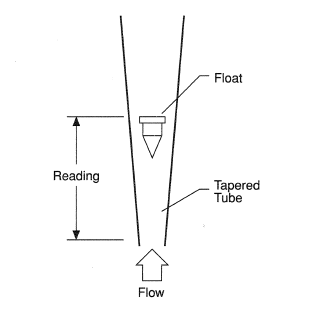An example of a rotameter is shown diagrammatically in Figure 1. It consists of a vertical tube with a tapered bore containing a float. The float rises in the tube as the flowrate increases and the flowrate can be read directly off a scale which is usually marked on the tube. Rotameters can be used to measure the volumetric flowrate of either liquid or gas and are amongst the simplest and cheapest flowmeters in use. The flowrange is typically 10:1 and accuracy is usually 2 per cent.
Glass tubes are most common but the material varies from inexpensive machined acrylics to chemically resistant glass. For large sizes metal tubes can be used and the scale is attached to the float and viewed through a glass fronted sighting compartment below.
A spherical float can be used but these are prone to unsteadiness so it is more usual to find floats of various designs such as the one shown in Figure 1. A well designed float's resistance is insensitive to Reynolds number and thus the differential pressure across the float is the same at all heights in the tube. Miller (1983) explains that the float height therefore varies with flowrate to expose the cross sectional flow area that satisfies Bernoulli's equation, hence the alternative name of variable area meter. Martin (1949) describes procedures for when the resistance of the float is not constant.
The scale on any rotameter relates to a particular density of fluid. Ower and Pankhurst (1977) explain that when operating with a fluid of slightly different density, the true flowrate can be calculated from  where Qi is the indicated flowrate, ρc is the calibration density and ρa is the operating density.
where Qi is the indicated flowrate, ρc is the calibration density and ρa is the operating density.
REFERENCES
Martin, J. J. (1949) Calibration of rotameters, Eng. Progress, 45, 338.
Miller, R. W. (1983) Flow Measurement Engineering Handbook, McGraw-Hill, New York.
Ower, E. and Pankhurst, R. C. (1977) The Measurement of Air Flow, Pergamon Press, Oxford.
References
- Martin, J. J. (1949) Calibration of rotameters, Eng. Progress, 45, 338.
- Miller, R. W. (1983) Flow Measurement Engineering Handbook, McGraw-Hill, New York.
- Ower, E. and Pankhurst, R. C. (1977) The Measurement of Air Flow, Pergamon Press, Oxford.
